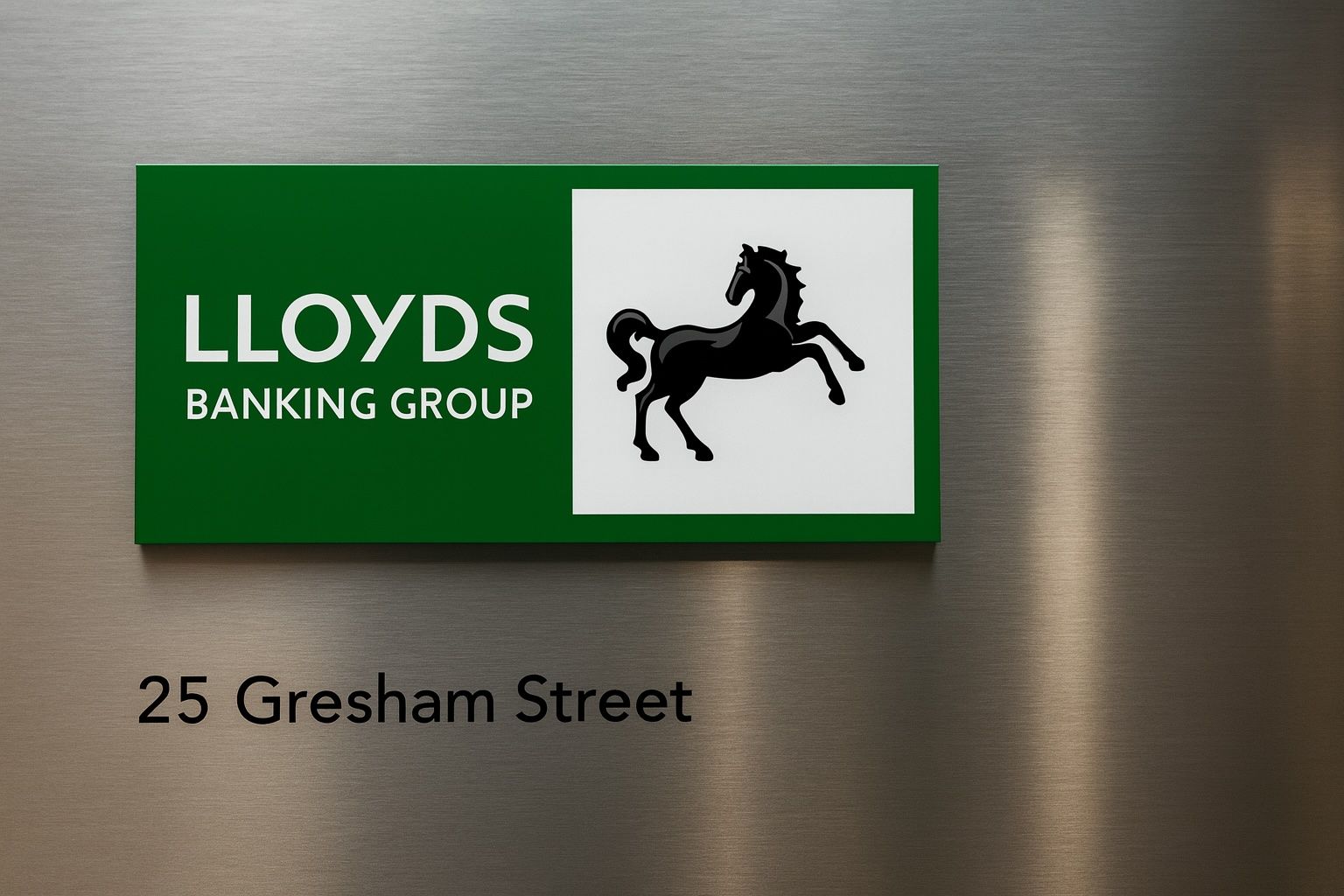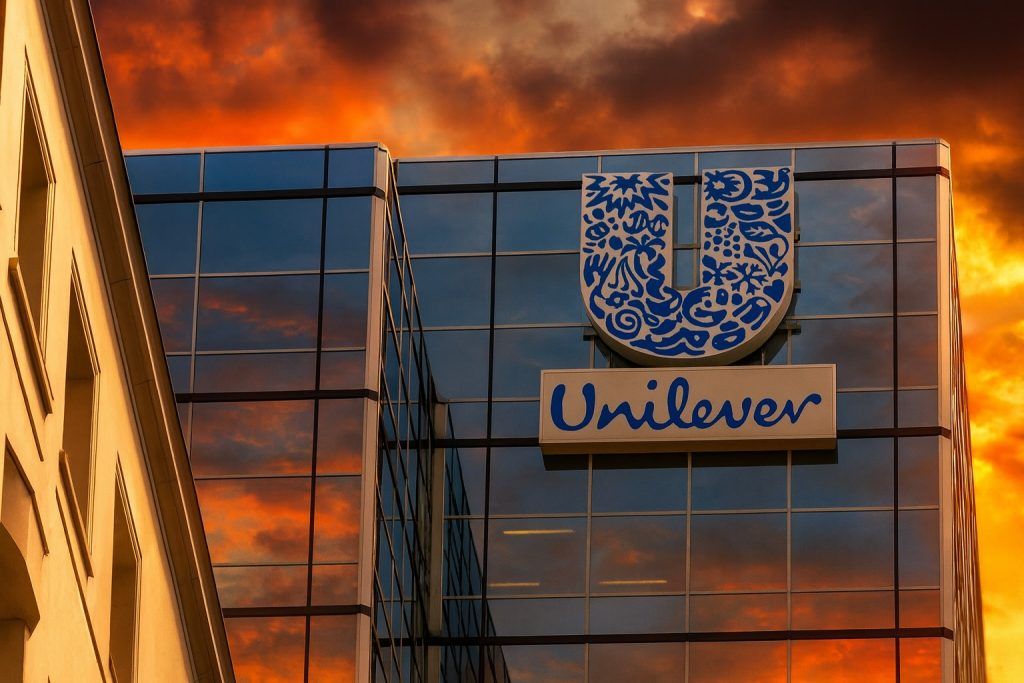- Current Share Price (Oct 23, 2025): ~84.1 pence per share [1], slightly below this month’s peak of ~86.6p – the highest level in 10 years [2].
- Daily Change & Volume: Shares traded flat-to-slightly lower (~–0.4%) in early Oct 23 session [3] [4] on above-average volume, as investors digested quarterly results and news flow.
- Year-to-Date Performance:+50% (approx.) over the past 12 months [5] [6] – Lloyds has dramatically outperformed the FTSE 100, reaching levels unseen since before the 2016 Brexit vote.
- Major Drivers: Robust Q3 earnings (profit £1.17 billion) with upgraded income guidance, tempered by a hefty £800 million provision for a motor finance mis-selling scandal [7] [8]. High UK interest rates are boosting Lloyds’ net interest margin, while fears of new bank taxes and regulatory costs cap optimism.
- Latest News:Third-quarter results (released Oct 23) showed a 36% profit drop due to the scandal charge, leading Lloyds to trim its full-year return on equity target (to ~12%) [9] [10]. Economic backdrop remains mixed – UK growth is steady and Bank of England policy is on hold, aiding bank profits, but political uncertainty (possible bank tax in Autumn Budget) is looming [11] [12].
Lloyds Share Price Rally Nears 10-Year High
Lloyds Banking Group (LSE: LLOY) stock has been on a tear in 2025, flirting with decade highs. Shares currently trade around 84–85 pence, just shy of their highest level since 2015 [13]. In mid-October, Lloyds hit ~86.6p, a level not seen since before the Brexit referendum, underscoring the bank’s remarkable recovery. The stock has climbed roughly 50% year-on-year, vastly outperforming the broader FTSE 100 index [14]. Elevated interest rates have turbocharged bank earnings, and Lloyds – as the UK’s largest retail lender – has been a prime beneficiary of fatter loan margins. Investors have also cheered the resumption of dividends and buybacks, viewing Lloyds’ capital returns favorably [15] [16]. “Lloyds Banking Group appears to be on solid footing… The share price is near its highest in a decade, supported by strong fundamentals and upbeat forecasts,” notes TS²’s market analysis [17]. However, after this 50% surge, some ask how much upside remains. At ~85p, LLOY now trades around 13× forecast earnings – pricier than many peers – which suggests much of the good news may be priced in [18]. Indeed, investor sentiment is cautiously optimistic at this stage: bulls point to Lloyds’ profit momentum, while bears note that any economic stumble or negative news could quickly check the rally [19] [20].
Recent Trading: In the days leading up to Oct 23, Lloyds stock saw volatile but resilient action. Last week (Oct 17), shares initially dipped nearly 3% on global bank jitters, but rebounded to finish flat around 85p [21] [22] – a sign of underlying strength. By Oct 19–22, LLOY hovered in the mid-80s pence, consolidating gains ahead of earnings. On Oct 23, the Q3 results prompted a knee-jerk selloff at the open, but the decline was modest. The stock was down about 0.4% early (vs. a flat FTSE 100) [23] [24], as traders reacted to mixed signals in the report. Notably, volume spiked on results day, indicating active rotation – around 30 million shares traded by midday, well above average. By afternoon, Lloyds largely recovered intraday losses, reflecting that investors found no major negative surprises beyond what was telegraphed. Year-to-date, Lloyds shares are up roughly 30–35% (and about 55% above their 2022 lows) [25]. This stellar performance has put LLOY near the top of 2025’s FTSE 100 leaderboard – a remarkable turnaround for a stock that languished in previous years.
Q3 Earnings: Solid Operating Results Marred by Scandal Costs
October 23rd brought Q3 results, and the numbers told a tale of two forces: strong underlying performance versus a one-off hit from legacy misconduct. Lloyds reported a pre-tax profit of £1.17 billion for Q3 (July–Sept 2025) [26]. Excluding charges, this was ahead of analyst expectations (~£1.0 bn consensus) [27], showcasing robust income and cost control. Net interest income (NII) – the difference between interest earned on loans and paid on deposits – jumped about 6% in the first nine months of 2025 [28]. The bank’s interest margin improved thanks to rate hikes and a savvy “structural hedge” strategy to lock in higher yields [29]. Lloyds also attracted £3.7 billion of net new money into its insurance and wealth arm year-to-date [30] [31], as it pushes into fee-based businesses. CEO Charlie Nunn lauded “strong capital generation… supported by income growth, cost discipline and strong asset quality,” despite the scandal costs [32]. Indeed, credit quality remains solid – UK unemployment ~4.3% and no housing crash means loan defaults are manageable so far [33] [34]. All this enabled management to upgrade 2025 guidance: Lloyds now sees underlying NII around £13.6 bn (up £100 m from prior forecast) [35], and it affirmed confidence in hitting 2026 targets.
However, the motor finance mis-selling scandal cast a long shadow. Earlier in October, Britain’s Financial Conduct Authority (FCA) proposed an industry-wide £11 billion redress scheme for years of mis-sold car loans [36]. Lloyds, which owns major auto lender Black Horse, had already provisioned £1.15 bn and warned that additional charges could be “material” [37] [38]. Those fears materialized: on Oct 13, Lloyds announced an £800 million top-up to its provisions [39], bringing the total set aside to £1.95 billion [40]. This nearly doubled the bank’s expected liability and is one of the costliest UK banking scandals in years. The Q3 results reflected that pain – the £800m hit drove profit 36% lower than Q3 2024 [41] and slashed quarterly return on tangible equity to 7.5% (from 15.2% a year prior) [42]. Lloyds also cut its full-year ROE guidance to ~12% (vs ~13.5% prior) to account for the charge [43]. Despite this, the market had largely anticipated the write-down. In fact, when Lloyds first flagged the potential hit on Oct 9, the stock slid ~3% intraday [44]. But after the actual provision came in at £800m (within analyst estimates of ~£1.5–1.8bn) [45] [46], investors breathed a sigh of relief. “There is some relief today that ‘material’ top-up didn’t equate to a much larger number,” noted RBC analyst Benjamin Toms when the figure was confirmed [47] [48]. Indeed, Lloyds shares jumped 1.6% on Oct 13 as clarity emerged [49]. By absorbing the charge now, Lloyds hopes to put the saga largely behind it. The bank even indicated it will challenge the FCA’s methodology in the courts [50] [51] – signaling it deems the payout formula overly punitive. CEO Nunn has publicly griped that the FCA’s plan could “take 20 years of profitability off the car finance industry” and hurt the sector’s “investability” [52] [53]. Still, with £2 bn set aside, Lloyds has girded for the worst-case and can move forward (even as legal wrangling continues).
Beyond the scandal, Lloyds had other notable news in October. On Oct 9, the group unveiled a strategic move in wealth management – buying out Schroders’ 49.9% stake in their joint venture, Schroders Personal Wealth (SPW) [54] [55]. In a stock-swap deal (no cash paid), Lloyds will take full control of SPW (with ~£17 bn in client assets) and rebrand it “Lloyds Wealth” [56] [57]. This plays into Lloyds’ push to serve “mass affluent” customers (those with ~£75k–£250k in deposits) [58] [59]. The bank wants to boost fee income from financial advice and investments, diversifying beyond lending. Analysts see promise: “Growing wealth in the UK is core to our purpose,” said Lloyds’ wealth chief, noting the deal brings unified offerings under one roof [60] [61]. Combined with its insurance arm (Scottish Widows) and a new AI-driven advisory platform, Lloyds is looking to close the gap with rivals in wealth management [62] [63]. This move came as UK banks broadly delivered strong Q3s – Barclays and NatWest also reported resilient profits – but all face political and regulatory headwinds.
Market Reactions and Investor Sentiment
The market’s response to Lloyds’ recent news has been cautiously positive. On one hand, earnings held up despite the scandal, and forward guidance even improved slightly, which reassured investors. Lloyds shares barely budged on results day, reflecting that much bad news was already “priced in”. “The bank navigated a major regulatory hurdle with manageable damage, and continues to churn out healthy profits,” observes TS² TechStock’s commentary [64] [65]. Lloyds’ capital ratios remain robust (CET1 ~14% [66] [67]), giving confidence it can weather future shocks and still return cash to shareholders. Importantly, Lloyds maintained its dividend (analysts expect ~3.6p per share in 2025, a ~4% yield [68] [69]) and a £2 bn buyback this year – signals that management sees value in the stock. These factors have kept overall sentiment tilted bullish. On social media and investor forums, many retail shareholders are celebrating Lloyds’ highest share price in a decade and speculating that the elusive 100p (£1) mark could finally be in sight. The stock’s hashtag has trended among UK finance circles as a 2025 comeback story, with discussions on whether to hold for further gains or secure profits now.
At the same time, there’s a vein of caution tempering the enthusiasm. Macro and political risks are on the radar. The UK’s new government is set to deliver an Autumn Budget next month (Nov 26), and there is widespread chatter about a potential bank tax hike [70] [71]. Analysts warn that an increase in the banking surcharge (e.g. from 3% to 5% on profits) could clip earnings and dampen bank share performance [72] [73]. “We think it right to expect a modest increase in bank tax,” wrote UBS analysts, noting any post-earnings rally might be “dampened by Budget fears” [74] [75]. This looming uncertainty has some investors hitting pause. “There’s limited appetite for domestic bank exposure ahead of the Budget,” one brokerage said, with funds possibly waiting to see the tax outcome [76] [77]. Additionally, the FCA’s aggressive stance (e.g. on motor finance) and talk of stricter regulations if banks don’t pass on rate rises to savers have introduced an overhang. Even Lloyds’ CEO hinted that populist pressures could invite more regulation or windfall taxes on banks’ “excess” profits [78]. Internationally, investor sentiment toward banks is jittery whenever recession risks or geopolitical tensions flare – a risk-off wave could knock even a domestically-focused lender like Lloyds. A recent example: mid-October’s brief selloff tied to U.S. regional bank woes saw Lloyds tumble 3%, before bouncing back [79] [80]. This underscores that confidence can be fragile in the sector [81] [82]. As one market commentator quipped, “spooked investors fear a crisis is brewing whenever banking stocks slide” [83] [84]. Thus, while the mood on Lloyds is largely optimistic, it’s also tinged with vigilance.
Analyst Views: Forecasts and Price Targets
City analysts remain broadly bullish on Lloyds, albeit with modest upside targets. The consensus 12-month price objective is in the 90–95 pence range [85]. Several brokers recently raised their targets into the high-90s pence after Lloyds’ strong run [86]. For instance, RBC Capital Markets reiterated a ~95p target, J.P. Morgan is around 98p, and Jefferies hiked its goal from 92p to 103p – effectively calling for ~20% upside [87]. These targets imply Lloyds would trade at a reasonable ~11–12× forward P/E, which analysts see as fair given earnings growth prospects [88]. Notably, if profits grow as forecast into 2027, Lloyds’ P/E would drop to only ~7.5×, indicating value longer-term [89] [90]. Dividend forecasts also entice: the market expects payouts to rise from ~3.6p in 2025 to 4.1p in 2026 and 4.8p in 2027, implying yields of 5–5.7% in coming years [91] [92]. With earnings comfortably covering these dividends 2× over [93] [94], Lloyds is positioned as an attractive income play. “Many investors buy Lloyds for income… the bank has restored and steadily increased payouts,” notes The Motley Fool, highlighting the 2025–27 dividend trajectory [95].
Looking ahead, independent forecasting sites project steady if unspectacular share price gains. PoundF.co.uk, for example, predicts LLOY could end October 2025 around 87.1p (a ~4.5% monthly rise), then 90.0p by November and 93.8p by December [96]. It even envisions the stock breaking £1 in early 2026 (potentially ~105p by March 2026) under favorable conditions [97]. Such optimism hinges on several tailwinds materializing: continued economic growth (or at least a “soft landing” with easing inflation), slightly higher net interest margins, and successful execution of Lloyds’ strategy. On that front, analysts are encouraged by Lloyds’ expansion moves – e.g. the Schroders Wealth deal and investments in digital banking and AI – which could bolster fee income and efficiency [98] [99]. RBC analysts Benjamin Toms and Ben Bathurst even floated the idea that Lloyds might pursue an acquisition like Quilter (a UK wealth manager) to turbocharge its wealth presence [100] [101]. They estimate buying Quilter (~£3bn deal) could make Lloyds the #2 UK wealth manager and lift earnings ~6% [102] [103]. While this is speculative, it underlines that management is keen on growth avenues beyond plain lending.
Risks & downside scenarios also feature in analysts’ calculus. A key concern is credit quality: as high borrowing costs bite, defaults could rise. Lloyds’ loan impairment charges jumped to £442 m in H1 2025 (vs £100m year prior) [104], and some analysts see annual provisions climbing toward £1.3–1.4 bn by 2027 [105] [106]. A spike in unemployment or house price drop would hit Lloyds harder than more diversified banks, given its heavy UK mortgage book. Competition in mortgages is another pressure – as rival lenders cut rates to chase business, net interest margins might peak and then compress. Lloyds acknowledged a “squeeze on mortgage margins” this quarter, though hedging gains offset it for now [107]. There’s also political/regulatory risk: beyond the pending tax changes, banks face intense scrutiny over savings rates and customer treatment. Any populist moves (like stricter lending rules or forced rate concessions) could crimp profits. The Bank of England’s future policy is a double-edged sword as well – while current high rates are profitable, an eventual rate cut cycle in 2026 could slow NII growth (though it might also ease default risks). Good Money Guide cautions that Lloyds may struggle to reach £1 in the near term partly because the stock already re-rated to ~11× earnings, leaving less room for multiple expansion [108]. “The share price might struggle to reach £1 in 2025 because [it] already trades on a P/E of around 11 and investors may book profits,” the outlet notes [109].
Technical Analysis and Outlook
From a chart perspective, Lloyds’ breakout above long-term resistance has been impressive. The stock spent much of 2018–2022 stuck in a 30–60p range, burdened by low rates and pandemic woes. This year it smashed through those ceilings. The 52-week high at ~86.6p now serves as immediate resistance – essentially the last hurdle before Lloyds could test the psychologically significant 100p level. If positive catalysts (e.g. benign economic data or a shareholder-friendly Budget) emerge, analysts believe Lloyds could grind into the 90s pence in the coming months [110]. Technical momentum indicators have been favorable; as of Oct 23, daily trend signals rated LLOY a “Strong Buy” on many measures [111]. However, the rally has also left the stock near overbought territory at times, so sideways consolidation or a pullback is always possible. On the downside, support levels to watch include ~80p (a round-number support and recent pullback area) and around 75p (where the 200-day moving average and a spring 2025 peak coincide). Barring unforeseen shocks, few expect a retrace anywhere near last year’s lows (~50p) – Lloyds’ fundamentals have markedly improved since then.
Short-term (weeks ahead): The stock may trade range-bound in the mid-80s as the market awaits the UK Budget and further macro clues. Bank earnings season is wrapping up, and Lloyds delivered no knockout surprises, so news flow could quiet down. One wildcard is broader market sentiment: global investors are eyeing central bank signals (Fed and BoE policy pivots) and geopolitical risks. Any rally in bonds (on rate cut hopes) could actually cap bank stocks like Lloyds, since their earnings thrive on higher yields. Conversely, if inflation data surprise to the upside, extending the high-rate environment, that could buoy Lloyds but might also stoke recession fears – a mixed bag. In the very near term, analysts say Lloyds will likely “tread water” around current levels, with a bias toward modest gains if no negative headlines emerge. Notably, investors are closely watching Oct 26, when the Bank of England’s Mortgage Charter deadline passes – banks pledged to help homeowners with rates, and how that plays out could influence sentiment on lenders.
Medium-term (into 2026): The trajectory for Lloyds appears moderately positive, albeit not as explosive as the past year. Most experts see earnings growing in 2025–26 (helped by stable margins and share buybacks) which should support a gradual uptrend in the share price [112] [113]. If the UK economy avoids a hard landing – i.e. low growth but no deep recession – Lloyds’ profits are forecast to keep rising into 2026 [114]. Under that base case, achieving 90–100p in the next 6–12 months is plausible. TS² analysis suggests that with a “soft landing” scenario (moderate growth, easing inflation), Lloyds’ current valuation is undemanding and “further share price appreciation” is justified, “albeit likely at a slower pace than the past year’s 50% leap” [115] [116]. The bank’s strong capital position also gives it flexibility – management could announce additional buybacks or special dividends in 2026 if excess capital builds, which would be a catalyst for the stock. On the strategic front, any successful expansion of the wealth and insurance business (organically or via acquisition) could lift the market’s growth expectations for Lloyds beyond the staid image of a “mature” UK bank.
In summary, Lloyds Banking Group’s share price is at a crossroads of opportunity and caution. The stock’s 2025 rally has showcased the bank’s profit power in a high-rate climate and investors’ renewed confidence in the “black horse” icon of British banking. A decade after the last peak, Lloyds is again within sight of the £1.00 milestone – a level long unimaginable during the post-Brexit and COVID downturns. Whether it can gallop that final stretch likely hinges on executing its strategy and navigating external risks. The coming months will test if Lloyds can justify the market’s optimism. If it delivers consistent earnings and avoids any new pitfalls, analysts see room for more upside – potentially making LLOY one of 2025’s standout comeback stories. But if economic winds shift or regulators tighten the reins, shareholders may need to brace for some bumps on the road. For now, the bank enters the year’s final quarter with considerable momentum and cautious optimism [117] [118] – a far cry from the uncertainty of years past, yet with challenges still looming on the horizon.
Sources: Official Q3 2025 filings (Lloyds Banking Group) and investor presentations; Reuters news reports [119] [120] [121]; TS2.tech market analysis and forecasts [122] [123]; Financial Times (FT.com) and City A.M. coverage [124] [125]; Bloomberg and Yahoo Finance commentary; Motley Fool UK insights [126]; UK regulatory announcements (FCA, BoE) [127] [128]. All information is up to date as of October 23, 2025.
References
1. www.investing.com, 2. ts2.tech, 3. www.reuters.com, 4. www.reuters.com, 5. ts2.tech, 6. ts2.tech, 7. www.reuters.com, 8. www.reuters.com, 9. www.reuters.com, 10. www.reuters.com, 11. www.cityam.com, 12. www.cityam.com, 13. ts2.tech, 14. ts2.tech, 15. ts2.tech, 16. ts2.tech, 17. ts2.tech, 18. ts2.tech, 19. ts2.tech, 20. ts2.tech, 21. ts2.tech, 22. ts2.tech, 23. www.reuters.com, 24. www.reuters.com, 25. ts2.tech, 26. www.reuters.com, 27. www.reuters.com, 28. www.reuters.com, 29. www.reuters.com, 30. www.reuters.com, 31. www.reuters.com, 32. www.reuters.com, 33. ts2.tech, 34. ts2.tech, 35. www.cityam.com, 36. www.reuters.com, 37. www.reuters.com, 38. www.reuters.com, 39. www.reuters.com, 40. www.reuters.com, 41. www.reuters.com, 42. www.cityam.com, 43. www.reuters.com, 44. www.reuters.com, 45. www.reuters.com, 46. www.reuters.com, 47. www.reuters.com, 48. www.reuters.com, 49. www.reuters.com, 50. www.reuters.com, 51. www.reuters.com, 52. www.cityam.com, 53. www.cityam.com, 54. www.reuters.com, 55. www.reuters.com, 56. www.reuters.com, 57. www.reuters.com, 58. www.reuters.com, 59. www.reuters.com, 60. www.reuters.com, 61. www.reuters.com, 62. ts2.tech, 63. ts2.tech, 64. ts2.tech, 65. ts2.tech, 66. ts2.tech, 67. ts2.tech, 68. ts2.tech, 69. ts2.tech, 70. www.cityam.com, 71. www.cityam.com, 72. www.cityam.com, 73. www.cityam.com, 74. www.cityam.com, 75. www.cityam.com, 76. www.cityam.com, 77. www.cityam.com, 78. ts2.tech, 79. ts2.tech, 80. ts2.tech, 81. ts2.tech, 82. ts2.tech, 83. ts2.tech, 84. ts2.tech, 85. ts2.tech, 86. ts2.tech, 87. ts2.tech, 88. ts2.tech, 89. ts2.tech, 90. ts2.tech, 91. ts2.tech, 92. ts2.tech, 93. ts2.tech, 94. ts2.tech, 95. ts2.tech, 96. ts2.tech, 97. ts2.tech, 98. ts2.tech, 99. ts2.tech, 100. ts2.tech, 101. ts2.tech, 102. ts2.tech, 103. ts2.tech, 104. ts2.tech, 105. ts2.tech, 106. ts2.tech, 107. www.reuters.com, 108. ts2.tech, 109. ts2.tech, 110. ts2.tech, 111. www.investing.com, 112. ts2.tech, 113. ts2.tech, 114. ts2.tech, 115. ts2.tech, 116. ts2.tech, 117. ts2.tech, 118. ts2.tech, 119. www.reuters.com, 120. www.reuters.com, 121. www.reuters.com, 122. ts2.tech, 123. ts2.tech, 124. www.cityam.com, 125. www.cityam.com, 126. ts2.tech, 127. www.reuters.com, 128. www.cityam.com







